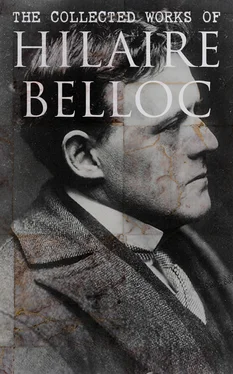The corresponding reference-numbers will be found in the following text.
2. Many of our historians carelessly talk of Harold being brought to Rouen. We have no proof of this. There is just one allusion in the Chronicles to the place where delivery of Harold’s body was made from Guy to William, and the place mentioned is what we should expect, a frontier town, Eu. The Palatium does not only mean a place , it also means an institution ; and though Rouen was William’s chief city, whenever he moved, his clerks and staff of government—that is, his “Palatium”—moved with him.
3. Mr. Oman in his version of the affair makes Bonneville the scene of the oath. I have not seen the proof of this. The two fundamental pieces of evidence—Wace and the Tapestry—both say Bayeux. William had a castle above the river Touques at Bonneville, and ruins of it, or of a later construction upon its site, can be seen to-day; but it is a good two days’ march from Bayeux.
The French word “parliament” meant, of course, any general assembly for discussion, and was here used of something earlier than any representative assembly, though these were already springing up in the Spanish March of the Pyrenees, to which district we owe the origin of representative institutions.
4. I have never understood why this third messenger should have been confused with Harold himself. The Latin inscription is quite clear: “Here they gave to Harold the Crown of King.” The people holding the axes are not Harold, neither is the man offering the crown, that I can see.
5. The Tapestry, of course, does not show Freeman’s famous “Palisade,” and that for an excellent reason. The Palisade never existed outside the imagination of Oxford.
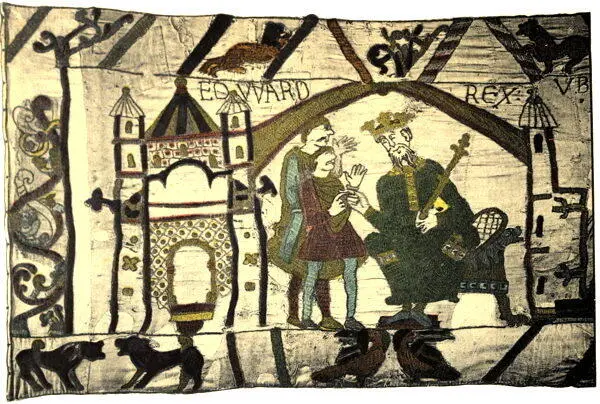
1

2
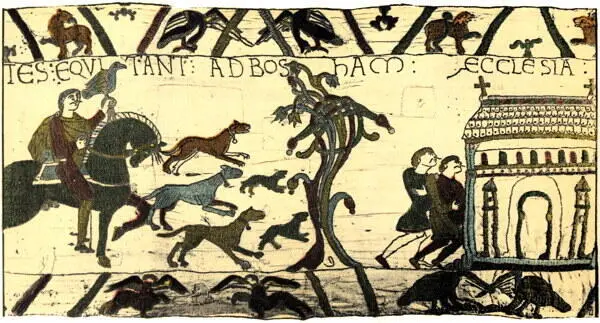
3

4
The first three sections of the Bayeux Tapestry must be taken together, for they describe one incident, which is the departure of Harold from Bosham the port of Chichester, and a manor of his own. Of strictly contemporary evidence to that journey we have none. We can only guess that the year in which it was taken was the year 1064. As to its motive the Bayeux Tapestry gives of course the current Norman version, or rather hints at it. Edward the Confessor is in his palace at Westminster. It is important to note the conventional signs of his rank, the sceptre and the crown. It is the reappearance of the same symbols in the crowning of Harold—which was in the Norman version his supreme act of treason—that is particularly insisted upon. Edward, thus officially presented as it were, is giving a message: that is certainly the symbolism of the attitude, and it is exceedingly likely, though not equally certain, that the person to whom the message is being given is intended for Harold. But it is remarkable that the inscription here says nothing of the nature of that message, and that the point of capital importance—William of Malmesbury’s assertion that Harold was sent by Edward to assure William of his succession to the English throne—is not set out. Taking Wace as the basis of the Tapestry—and this is the best hypothesis—Harold sailed to release from William’s custody his brother Wulfnoth, who had been kept as a hostage in Normandy for King Edward to guarantee King Edward the fidelity of Godwin. But we must remember that the Roman de Rou does mention Edward’s sending Harold to assure William of the succession. And on the whole it is most likely that the intention of the Tapestry is to suggest this. Harold and his knights ride to Bosham. Harold himself is conventionally distinguished by the hawk on the wrist. The Church of Bosham is introduced into the story probably or certainly with the object of emphasizing (as the Tapestry perpetually does) the religious enormity of Harold’s later action, and both this visit to the Church and the Feast in the Upper Room before embarking, which forms the fourth episode, are clearly intended to refer to incidents which were traditional in the Norman story. But we have, I think, no remaining text giving either the visit to the Church or the Feast.
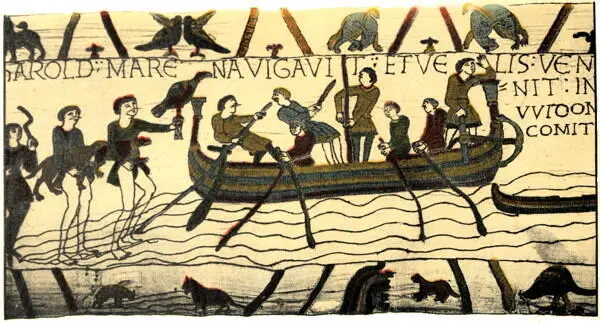
5
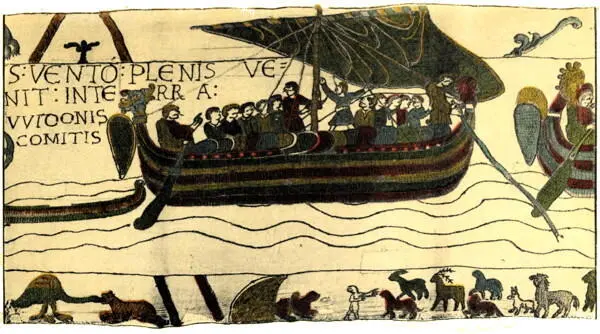
6

7
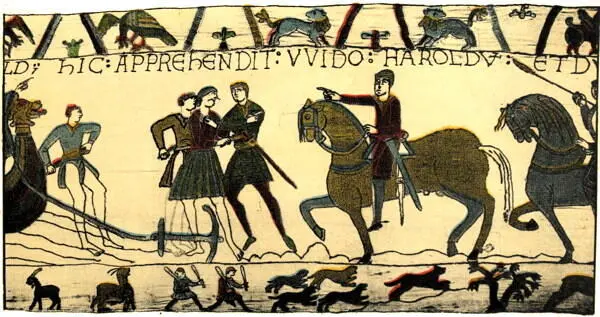
8
In the fifth division Harold and his suite embark, and it should be noted how large a company the Convention of the Tapestry supposes.
The intention of the expedition was almost certainly to make a Norman port. Once in the Channel the square-rigged ships could not beat into a wind that was too westerly for them or too much south of west, and their land-fall was at some point upon the coast of Ponthieu, of which district Count Guy was the lord. The point upon the coast of Ponthieu where the ships beached, or rather cast anchor in the shoal water, we may presume to have been the right bank of the estuary of the Somme, for it is the most convenient entry and has some shelter from a southerly wind; but all that flat sandy coast gave good opportunity for landing from such vessels, and the fleet may have made the Bay of Authie or even the mouth of the Canche. But the choice is not a wide one, for the coast of Ponthieu did not extend beyond the Canche. If the Somme were the point of entry, it has this historical interest: that Harold would then have found himself fated to land at the very point from which William two years later was to sail for the invasion of England. Count Guy seized Harold for ransom, something of a formality, though a formality which was to be of formidable consequence. He takes Harold and his suite to “Belrem”—the place to-day called Beaurain. Here the Tapestry follows Wace very closely, for it is Wace who tells us that Harold was recognised by a fisherman, who sent for Count Guy.
The capital of Ponthieu was Montreuil, and this castle of Beaurain, of which ruins still stand, was six or seven miles up the river from Montreuil—one passes right beneath it in the railway to-day on one’s way to Hesdin.

9

10

11
Читать дальше
